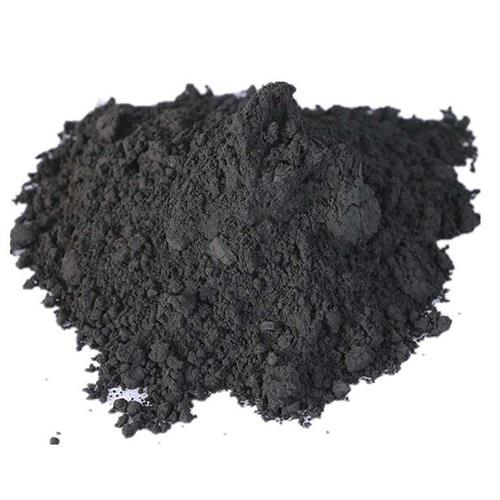|
| | Cobalt oxide Chemical Properties |
| Melting point | 1785 °C | | density | 6.45 | | vapor pressure | 0Pa at 20℃ | | form | Powder | | color | Green-brown | | Specific Gravity | 6.45 | | Water Solubility | insoluble | | Sensitive | Air Sensitive | | Merck | 14,2446 | | Exposure limits | ACGIH: TWA 1 mg/m3
OSHA: TWA 15 mg/m3; TWA 5 mg/m3 | | Stability: | Stability Stable, but may be moisture sensitive. | | InChI | InChI=1S/Co.O | | InChIKey | IVMYJDGYRUAWML-UHFFFAOYSA-N | | SMILES | O=[Co] | | CAS DataBase Reference | 1307-96-6(CAS DataBase Reference) | | NIST Chemistry Reference | Cobalt monoxide(1307-96-6) | | EPA Substance Registry System | Cobalt(II) oxide (1307-96-6) |
| | Cobalt oxide Usage And Synthesis |
| Cobalt oxides | Cobalt oxides have three oxidation states, namely: (i) cobaltous oxide (cobalt monoxide or cobalt [II] oxide) with CoO chemical formula, (ii) cobaltic oxide (cobalt [III] oxide) with Co2O3 chemical formula and (iii) cobaltosic oxide (cobalt [II, III] oxide) with Co3O4 chemical formula, which is an antiferromagnetic material. The first and the last oxidation states have a cubic crystal structure.
Cobalt oxide is used in pigments for ceramics, in glass coloring and decolorization, as oxidation catalyst for drying oils, and fast-drying paints and varnishes, in preparation of cobalt-metal catalysts, and cobalt powder for binder in sintered tungsten carbide; in semiconductors. | | Uses | Cobalt(II) oxide is used as a pigment for ceramics and paints; for drying paints, varnishes and oils; for coloring glass; as a catalyst; and for preparation of other cobalt salts. The commercial product is a mixture of cobalt oxides.
| | Preparation | Cobalt(II) oxide is prepared by heating cobalt(II) carbonate, CoCO3, cobalt(III) oxide, Co2O3 or tricobalt tetroxide, Co3O4, at high temperatures in a neutral or slightly reducing atmosphere:
CoCO3 → CoO + CO2
| | Toxicity | Cobalt(II) oxide is moderately toxic by ingestion and subcutaneous and intratracheal routes.
LD50 oral (rat): 202 mg/kg
| | Description | This is obtained as an olive-green powder by heating the metal in air or steam or by thermal decomposition of the hydroxide, carbonate or nitrate. It has the sodium chloride lattice and is antiferromagnetic below 292°K. When heated in oxygen above 400° the black oxide Co3O4 is obtained. This oxide is isomorphous with magnetite Fe3O4, and has tetrahedrally surrounded cobalt(II) ions and octahedrally surrounded cobalt(III) ions. Both these oxides are readily reduced to the metal by heating in hydrogen or with carbon. The reactions of CoO with silica, alumina and zinc oxide are used to form pigments in the ceramic industry. | | Chemical Properties | Cobalt oxide is a high-valent oxide of cobalt, with a theoretical cobalt content of 71.06% and an oxygen content of 28.94%, which is a black amorphous powder. Cobalt oxide is a kind of unstable and impossible free state compound, usually refers to the cobalt oxide are attached with a certain amount of cobalt tetraoxide when heated cobalt oxide is reduced to cobalt tetraoxide. The theoretical cobalt content of cobalt tetraoxide is 73.43% and the oxygen content is 26.57%, with the appearance of gray-black or black powder.

The cobalt oxide used in batteries is cobalt tetraoxide, which has a spinel structure. It can be used as anode material for lithium-ion batteries and is also the main raw material for the preparation of lithium cobaltate, the cathode material for lithium-ion batteries. | | Physical properties | The commercial product is usually dark grey powder, but the color may vary from olive geeen to brown depending on particle size; density 6.44 g/cm3, which also may vary between 5.7 to 6.7 g/cm3, depending on the method of preparation; melts around 1,830°C; insoluble in water; soluble in acids and alkalis. | | Uses | In pigments for ceramics; glass coloring and decolorization; oxidation catalyst for drying oils, fast-drying paints and varnishes; preparation of cobalt-metal catalysts, Co powder for binder in sintered tungsten carbide; in semiconductors. | | Uses | Cobalt oxide, typically 3.4-4.5%, Molybdenum oxide typically 11.5-14.5% on alumina is used in the preparation of biofuel production by using algae. | | Flammability and Explosibility | Notclassified |
| | Cobalt oxide Preparation Products And Raw materials |
|



